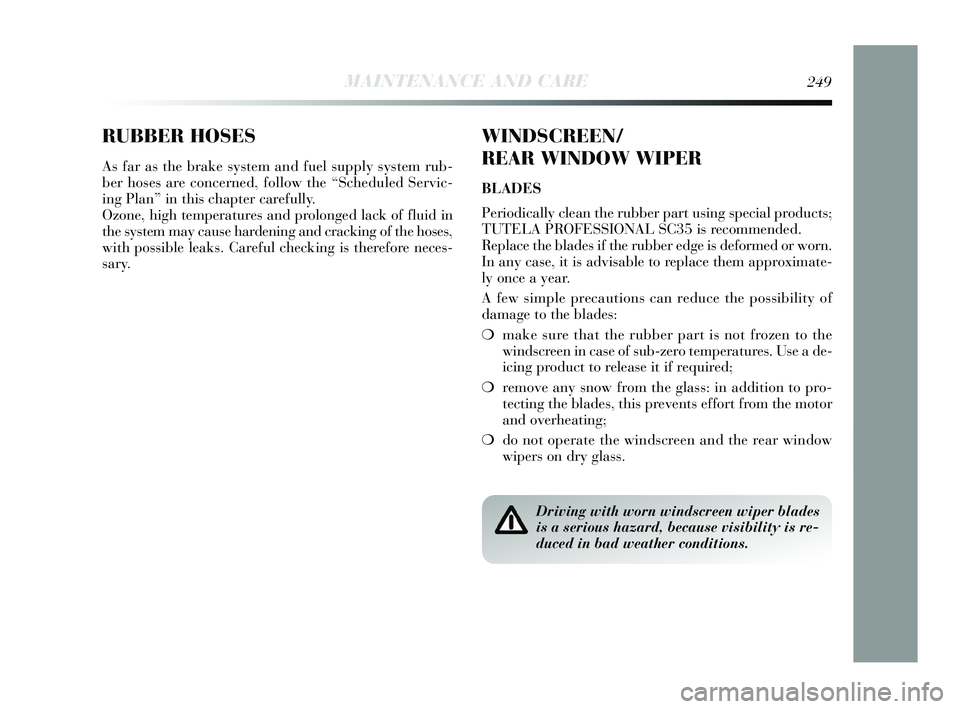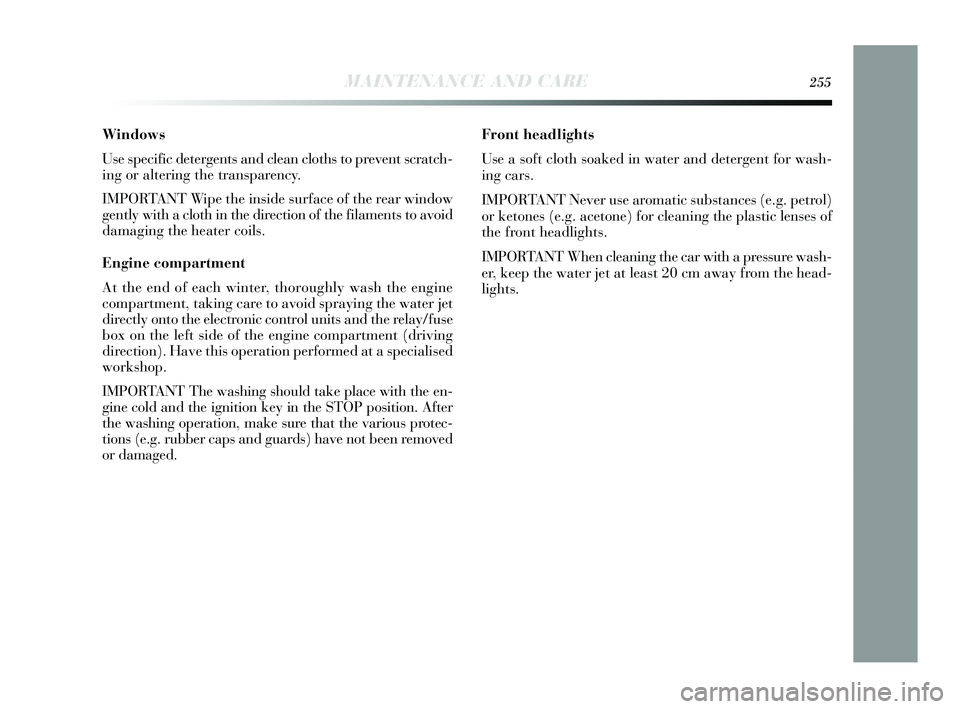Lancia Delta 2015 Owner handbook (in English)
Manufacturer: LANCIA, Model Year: 2015, Model line: Delta, Model: Lancia Delta 2015Pages: 291, PDF Size: 6.74 MB
Page 251 of 291

RUBBER HOSES
As far as the brake system and fuel supply system rub-
ber hoses are concerned, follow the “Scheduled Servic-
ing Plan” in this chapter carefully.
Ozone, high temperatures and prolonged lack of fluid in
the system may cause hardening and cracking of the hoses,
with possible leaks. Careful checking is therefore neces-
sary.
WINDSCREEN/
REAR WINDOW WIPER
BLADES
Periodically clean the rubber part using special products;
TUTELA PROFESSIONAL SC35 is recommended.
Replace the blades if the rubber edge is deformed or worn.
In any case, it is advisable to replace them approximate-
ly once a year.
A few simple precautions can reduce the possibility of
damage to the blades:
❍make sure that the rubber part is not frozen to the
windscreen in case of sub-zero temperatures. Use a de-
icing product to release it if required;
❍ remove any snow from the glass: in addition to pro-
tecting the blades, this prevents effort from the motor
and overheating;
❍ do not operate the windscreen and the rear window
wipers on dry glass.
Driving with worn windscreen wiper blades
is a serious hazard, because visibility is re-
duced in bad weather conditions.
MAINTENANCE AND CARE249
233-256 Delta GB 1ed 03/04/14 13:28 Pagina 249
Page 252 of 291

250MAINTENANCE AND CARE
Replacing the windscreen wiper blades fig. 3
Proceed as follows:
❍lift the windscreen wiper arm and position the blade
so that it forms an angle of 90° with the arm;
❍ press tab A and remove the blade from the arm;
❍ insert the new blade making sure it is locked into place.
fig. 3L0E0097m
Changing the rear window wiper blade fig. 4
Proceed as follows:
❍ raise cover A and remove the arm from the car, slack-
ening nut B that fastens it to the pivot pin;
❍ fit the new arm, positioning it correctly, and fully tight-
en the nut;
❍ lower the cover.
fig. 4L0E0098m
233-256 Delta GB 1ed 03/04/14 13:28 Pagina 250
Page 253 of 291

NOZZLES
Windscreen washer fig. 5
If the jet of fluid is inadequate, firstly check that there is
fluid in the reservoir: (see “Checking levels” paragraph in
this chapter).
Then check that the nozzle holes are not clogged, if nec-
essary clean them using a needle.
The windscreen jets are directed by adjusting the nozzle
angle.
The jets should be directed at about a third of the height
from the top edge of the windscreen.
IMPORTANT In versions with a sun roof, make sure that
the sun roof is closed before operating the front jets.
fig. 5L0E0099m
Rear window washer fig. 6
The rear window washer jets are fixed. The nozzle hold-
er is located above the rear window.
fig. 6L0E0100m
MAINTENANCE AND CARE251
233-256 Delta GB 1ed 03/04/14 13:28 Pagina 251
Page 254 of 291

252MAINTENANCE AND CARE
BODYWORK
PROTECTION AGAINST ATMOSPHERIC AGENTS
The main causes of corrosion are the following:
❍atmospheric pollution;
❍ salty air and humidity (coastal areas, or hot humid cli-
mates);
❍ seasonal environmental conditions.
The abrasive action of wind-borne atmospheric dust and
sand, as well as mud and gravel raised by other cars is
also not to be underestimated.
On your car, Lancia has implemented the best manufac-
turing technologies to effectively protect the bodywork
against corrosion. These include:
❍
paint products and systems which give the car a spe-
cial resistance to corrosion and abrasion;
❍ use of galvanised (or pre-treated) steel sheets with high
resistance to corrosion;
❍ spraying the underbody, engine compartment, wheel
arch internal parts and other elements with highly pro-
tective wax-based products;
❍ spraying protective plastic materials in the most ex-
posed areas: underdoor, inner wing parts, edges, etc.;
❍ using “open” boxed sections to prevent condensation
and pockets of moisture from causing rust inside.
BODY AND UNDERBODY WARRANTY
Your car is covered by warranty against perforation due
to rust of any original element of the structure or body-
work.
For the general terms of this warranty, refer to the War-
ranty Booklet.
233-256 Delta GB 1ed 03/04/14 13:28 Pagina 252
Page 255 of 291

❍wash the bodywork using a low pressure jet of water;
❍ wipe a sponge with a slightly soapy solution over the
bodywork, frequently rinsing the sponge;
❍ rinse well with water and dry with a jet of air or a
chamois leather.
Dry the less visible parts with special care, such as the door
frames, bonnet and the headlight frames, where water may
stagnate more easily. The car should not be taken to a
closed area immediately, but left outside so that residual
water can evaporate.
Do not wash the car after it has been left in the sun or with
the bonnet hot: this may alter the shine of the paintwork.
Exterior plastic parts must be cleaned in the same way
as the rest of the car.
Where possible, do not park under trees; the resinous sub-
stance that many species release give the paint a dull ap-
pearance and increase the possibility of triggering rust-
ing processes.
ADVICE FOR PRESERVING THE BODYWORK
Paintwork
Paintwork does not only serve an aesthetic purpose, but
also protects the underlying sheet metal.
Touch up abrasions and scratches immediately to prevent
rust formation. Use only original paint products for touch-
ups (see “Bodywork paint identification plate” in the
“Technical specifications” chapter).
Normal maintenance of paintwork consists in washing the
car: the frequency depends on the conditions and envi-
ronment where the car is used. For example, in highly pol-
luted areas, or if the roads are spread with salt, it is ad-
visable to wash the car more frequently.
To correctly wash the car, proceed as follows:
❍
if taking your car through an automatic car wash, re-
move the aerial from the roof to avoid damaging it;
❍ in washing stations keep the steam jets/high pressure
washing nozzles at least 40 cm away from the body-
work to prevent damage. It should be remembered that
the build up of water can damage the car over a peri-
od of time;
MAINTENANCE AND CARE253
233-256 Delta GB 1ed 03/04/14 13:28 Pagina 253
Page 256 of 291

254MAINTENANCE AND CARE
In order to preserve the aesthetic appear-
ance of the paintwork abrasive products
and/or polishes should not be used for clean-
ing the car.
Detergents pollute the environment. Only
wash the car in areas equipped for the col-
lection and purification of the fluids used in
the washing process.
Hard Black versions
Avoid washing with rollers and/or brushes
in washing stations. Then, wash the car, on-
ly by hand, using pH-neutral detergents; dry
it with a wet chamois leather. Abrasive products
and/or polishes should not be used for cleaning the
car. Bird droppings must be washed off immediately
and thoroughly as the acid they contain is partic-
ularly aggressive. Avoid (if at all possible) park-
ing the car under trees; remove vegetable resins im-
mediately as, when dried, it may only be possible
to remove them with abrasive products and/or pol-
ishes, which is highly inadvisable as they could al-
ter the typical opacity of the paint. Do not use pure
windscreen washer fluid for cleaning the front
windscreen and rear window; dilute it min. 50%
with water.
IMPORTANT Bird droppings must be washed off imme-
diately and thoroughly, as the acid they contain is par-
ticularly aggressive.
233-256 Delta GB 1ed 03/04/14 13:28 Pagina 254
Page 257 of 291

MAINTENANCE AND CARE255
Windows
Use specific detergents and clean cloths to prevent scratch-
ing or altering the transparency.
IMPORTANT Wipe the inside surface of the rear window
gently with a cloth in the direction of the filaments to avoid
damaging the heater coils.
Engine compartment
At the end of each winter, thoroughly wash the engine
compartment, taking care to avoid spraying the water jet
directly onto the electronic control units and the relay/fuse
box on the left side of the engine compartment (driving
direction). Have this operation performed at a specialised
workshop.
IMPORTANT The washing should take place with the en-
gine cold and the ignition key in the STOP position. After
the washing operation, make sure that the various protec-
tions (e.g. rubber caps and guards) have not been removed
or damaged.Front headlights
Use a soft cloth soaked in water and detergent for wash-
ing cars.
IMPORTANT Never use aromatic substances (e.g. petrol)
or ketones (e.g. acetone) for cleaning the plastic lenses of
the front headlights.
IMPORTANT When cleaning the car with a pressure wash-
er, keep the water jet at least 20 cm away from the head-
lights.
233-256 Delta GB 1ed 03/04/14 13:28 Pagina 255
Page 258 of 291

256MAINTENANCE AND CARE
INTERIORS
Periodically check that water is not trapped under the mats
(due to water dripping off shoes, umbrellas, etc.) which
could cause oxidisation of the sheet metal.
Never use flammable products, such as
petrol ether or rectified petrol to clean the
inside of the car. The electrostatic charges
which are generated by rubbing during cleaning
may cause a fire.
Do not keep aerosol cans in the vehicle: these
could explode. Aerosol cans must not be ex-
posed to temperatures exceeding 50°C. When
the vehicle is exposed to sunlight, the temperature
inside can greatly exceed this value.
SEATS AND FABRIC PARTS
Remove dust with a soft brush or a vacuum cleaner. It is
advisable to use a moist brush on velvet upholstery.
Rub the seats with a sponge moistened with a solution of
water and neutral detergent.
PLASTIC PARTS
It is advisable to clean interior parts with a moist cloth and
a solution of water and non-abrasive mild soap. Use spe-
cific products for cleaning plastic, without solvents and
specifically designed to prevent damage to the appearance
and colour of the treated parts, to remove grease and tough
stains.
IMPORTANT Do not use alcohol, petrols or derivatives to
clean the instrument panel lens.
233-256 Delta GB 1ed 03/04/14 13:28 Pagina 256
Page 259 of 291

6
TECHNICAL SPECIFICATIONS257
Identification data ........................................................... 258
Engine codes - bodywork versions .................................... 260
Engine ........................................................................\
.... 261
Fuel supply syst em .......................................................... 262
Transmission ................................................................... 262
Brakes ........................................................................\
..... 263
Suspension ...................................................................... 263
Steering .......................................................................\
... 263
Wheels ........................................................................\
.... 264
Dimensions ..................................................................... 269
Performance ................................................................... 270
Weights .......................................................................\
.... 271
Capacities .......................................................................\
272
Fluids and lubr icants ...................................................... 273
Fuel consumpt ion ........................................................... 275
CO
2emissions ................................................................. 276
257-280 Delta GB 1ed 02/09/13 09.37 Pagina 257
Page 260 of 291

258TECHNICAL SPECIFICATIONS
IDENTIFICATION DATA
The vehicle identification details are, fig. 1:
1 V.I.N. plate (located in the engine compartment, to theside of the right shock absorber upper mounting);
2 Bodyshell marking (located on the passenger compart- ment floor, next to the passenger side front seat);
3 Bodywork paint identification plate (located on the in- side of the tailgate);
4 Engine marking (located on the left rear section, gear- box side). V.I.N. PLATE fig. 2
This plate is fitted to the engine compartment front cross-
member and contains the following data:
B Type-approval number.
C Vehicle type identification code.
D Chassis number.
E Maximum authorised weight of vehicle fully laden.
F Maximum authorised weight of vehicle fully laden plus
trailer.
G Maximum authorised weight on first axle (front).
H Maximum authorised weight on second axle (rear).
I Engine type.
L Bodywork version code.
M Spare parts number.
N Correct value of smoke coefficient (for diesel engines)
fig. 1L0E0116mfig. 2L0E0117m
257-280 Delta GB 1ed 02/09/13 09.37 Pagina 258